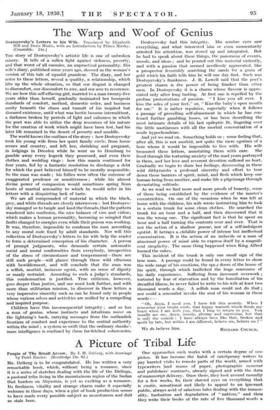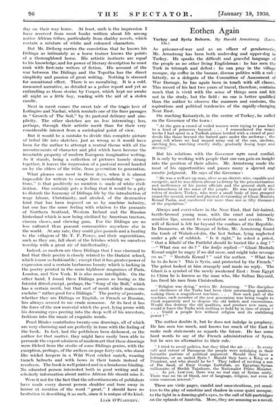A Picture of Tribal Life
People of The Small Arrow. By J. H. Driberg, with drawings by Pearl Binder. (Routledge 19s. 6d.)
Mn. Driberg is to be congratulated. He has written a very remarkable book, which, without being a romance, since it is a series of sketches dealing with the life of the Didinga, a pastoral tribe living in the mountainous region of the Sudan that borders on Abyssinia, is yet as exciting as a romance.
Its freshness, vitality and strange charm make it especially welcome in these days, when a glut of book production seems to have made every possible subject as monotonous and dull as stale beer.
One approaches such works with a certain degree of sus• picion. It has become the habit of catchpenny writers to pay hurried visits to remote parts of the world, armed with typewriters !and reams of paper, photographic cameras and publishers' contracts, already signed and with the date of manuscript delivery. Once there, they look around casually for a few weeks, fix their shrewd eyes on everything that is exotic, sensational and likely to appeal to an ignorant public, always avid of salacious tales dealing with the immor- ality, barbarism and degradation of " natives," and then they write their books at the rate of five thousand words a
day on their way home. At least, such is the impression I have received from most books written about life among native African tribes, particularly from shabby novels, which contain a mixture of white and coloured characters.
But Mr. Driberg carries the conviction that he knows his Didinga as intimately as a horse trainer knows the points of a thoroughbred horse. His artistic instincts are equal to his knowledge,and for power of literary description he must rank with first-rate writers of fiction. His account of the war between the Didinga and the Topotha has the direct simplicity and passion of great writing. Nothing is stressed for sensational effect. There is no moralizing. It is a cold, measured narrative, as detailed as a police report and yet as enthralling as those stories by Cooper, which kept me awake all night as a little boy, reading with the aid of a stolen candle.
Next in merit comes the sweet tale of the tragic love of Lotingiro and Nachai, which reminds one of the finer passages in " Growth of The Soil," by its pastoral delicacy and sim- plicity. The other sketches are no less interesting ; less, perhaps, through their artistic merit than for their very considerable interest from a sociological point of view.
But it would be a mistake to divide this complete picture of tribal life into sketches, just as wrong as it would have been for the author to attempt a central theme with all the accoutrements of character and plot which have become the invariable property of modern European imaginative writing. As it stands, being a collection of pictures loosely strung together, it leaves the impression of a pastoral record handed on by the elders of the tribe, from generation to generation.
What pleases one most in these days, when it is almost impossible for writers to escape from moralizing on " ques- tions," is that positively no mention is made of white civil- ization. One certainly gets a feeling that it would be a pity to disturb the harmony of Didinga life by the introduction of wage labour, Christianity, and alcohol, of the destructive kind that has been imposed on us by machine industry, but one has the same feeling with relation to the peasants of Northern Scotland, Western Ireland and the Russian hinterland which is now being civilized by American tractors, cinema shows, and chewing gum. For the Didinga are no less cultured than peasant communities anywhere else in the world. At any rate, they could give pounds and a beating to the villagers of Mr. T. F. Powys, and their superstitions, such as they are, fall short of the fetishes which we ourselves worship with a great air of intellectuality.
Indeed, so modern are these Didinga that I was charmed to find that their poetry is closely related to the Dadaist school, which is now so fashionable ; except that it has greater power of expression and a certain barbarous beauty which is lacking in the poetry printed in the more highbrow magazines of Paris, London, and New York. It is also more intelligible. On the other hand, I found these Didinga poems as boring as the futurist drivel, except, perhaps, the " Song of the Bull," which has a certain merit, but that sort of merit which makes one exclaim " rather good for a Didinga." The poetry of peasants, whether they arc Didinga or English, or French or Russian, has always seemed to me crude nonsense. At its best, it has the force of the raw material which the poet, lying prone with his dreaming eyes peering into the deep well of his ancestors, fashions into the music of exquisite words.
Pearl Binder contributes twenty-one drawings, all of which arc very charming and are perfectly in tune with the feeling of the book. In fact, had the publishers been dishonest, or the author for that matter, they might have easily been able to persuade the expert admirers of modern art that these drawings were filched from the studio of some Didinga genius, with the exception, perhaps, of the archers on page forty-six, who stand like wicket keepers in a Wild West cricket match, wearing trench helmets and with bows in their hands instead of revolvers. The book is well printed and in a handsome binding. No educated person interested both in good writing and in scholarly information about native African life should miss it.
Were it not for the fact that the advertisements of publishers have made every decent person shudder and turn away in horror at mention of the word " great," I should have no hesitation in describing it as such, since it is unique of its kind.







































 Previous page
Previous page